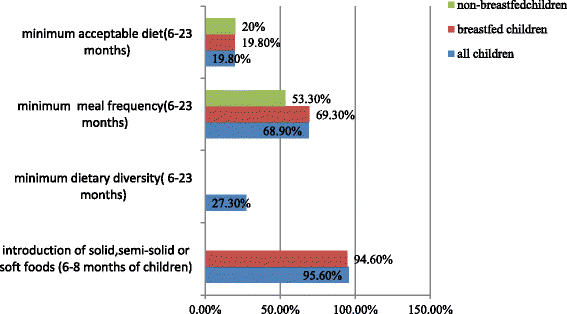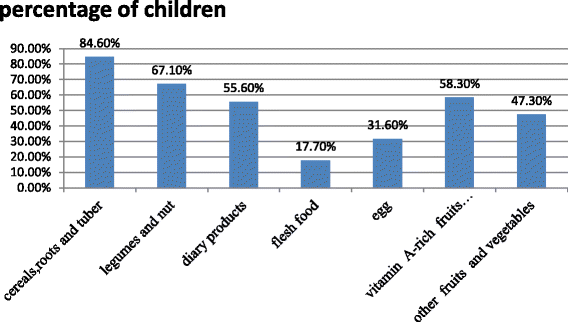Meal frequency and dietary diversity feeding practices among children 6-23 months of age in Wolaita Sodo town, Southern Ethiopia
- PMID: 28526058
- PMCID: PMC5437677
- DOI: 10.1186/s41043-017-0097-x
Meal frequency and dietary diversity feeding practices among children 6-23 months of age in Wolaita Sodo town, Southern Ethiopia
Abstract
Background: Child feeding practices are multidimensional, and they change rapidly within short age intervals. Suboptimal complementary feeding practices contribute to a rapid increase in the prevalence of undernutrition in children in the age of 6-23 months. Information on child feeding practices among urban resident is limited in Ethiopia. The aim was to measure minimum meal frequency and dietary diversity and associated factors among children 6-23 months of age in Wolaita Sodo, Ethiopia.
Methods: A community-based cross-sectional study was carried out to select 623 mothers/caregivers with 6-23 months of children reside in Wolaita Sodo town using systematic sampling from March 02 to 20, 2015. An interviewer-administered questionnaire was used to gather information on socio-demographic, child feeding practices and health-related characteristics. Data were entered to Epi-Data version 3.02 and transported to SPSS version 21 for further analysis. Binary logistic regression was used to see the association between the outcome variables and explanatory variables, and multivariable logistic regression was performed to identify independent predictors of minimum dietary diversity and meal frequency.
Results: The study revealed that the percentage of 6-23 months of children who meet the recommended level of minimum dietary diversity and meal frequency were 27.3 and 68.9%, respectively. Mothers/caregivers who were housewives and government employees feed their children more diversified foods as compared to mothers who were private workers. As compared to children 17-23 months of age, children in the age group of 6-8 and 9-11 months had better probability to meet minimum dietary diversity. Government-employed and illiterate mothers were less likely to feed their children to fulfil the minimum requirement of meal frequency. Children in the age of 9-11 months were also less likely to be fed frequently.
Conclusions: Even though the study showed better progress as compared to the national prevalence of complementary feeding practices, child feeding practices in the study area were inadequate and not achieving WHO infant and young child feeding recommendations. Strengthening the available strategies and creating new intervention measures to improve socioeconomic status, maternal literacy and occupation opportunity for better practices of child feedings are compulsory actions for the government and policymakers.
Keywords: 6–23 months of children; Dietary diversity; Meal frequency; Southern Ethiopia.
Figures
Similar articles
-
Dietary Diversity and Meal Frequency Practices among Children Aged 6-23 Months in Agro Pastoral Communities in Afar Region, Ethiopia: A Cross-sectional Study.Ecol Food Nutr. 2019 Nov-Dec;58(6):575-596. doi: 10.1080/03670244.2019.1644328. Epub 2019 Jul 29. Ecol Food Nutr. 2019. PMID: 31353951
-
Complementary feeding practices and associated factors among HIV positive mothers in Southern Ethiopia.J Health Popul Nutr. 2015 May 1;34:5. doi: 10.1186/s41043-015-0006-0. J Health Popul Nutr. 2015. PMID: 26825277 Free PMC article.
-
Dietary diversity, meal frequency and associated factors among infant and young children in Northwest Ethiopia: a cross- sectional study.BMC Public Health. 2015 Oct 3;15:1007. doi: 10.1186/s12889-015-2333-x. BMC Public Health. 2015. PMID: 26433689 Free PMC article.
-
Dietary diversity feeding practice and its associated factors among children age 6-23 months in Ethiopia from 2011 up to 2018: a systematic review and meta-analysis.Ital J Pediatr. 2018 Sep 17;44(1):109. doi: 10.1186/s13052-018-0567-9. Ital J Pediatr. 2018. PMID: 30223854 Free PMC article.
-
Determinants of Child Malnutrition and Infant and Young Child Feeding Approaches in Cambodia.World Rev Nutr Diet. 2016;115:61-7. doi: 10.1159/000444609. Epub 2016 May 19. World Rev Nutr Diet. 2016. PMID: 27197522 Review.
Cited by
-
Trend and determinants of minimum dietary diversity consumption change among children aged 6-23 months in Ethiopia from 2011 to 2019: A multivariate decomposition analysis.PLoS One. 2024 Aug 2;19(8):e0308349. doi: 10.1371/journal.pone.0308349. eCollection 2024. PLoS One. 2024. PMID: 39093880 Free PMC article.
-
Minimum dietary diversity and its associated factors among infants and young children in Ethiopia: evidence from Ethiopian Demographic and Health Survey (2016).Heliyon. 2022 Jan 7;8(1):e08727. doi: 10.1016/j.heliyon.2022.e08727. eCollection 2022 Jan. Heliyon. 2022. PMID: 35059521 Free PMC article.
-
Minimum meal frequency and associated factors among children aged 6-23 months in Sub-Saharan Africa: a multilevel analysis of the demographic and health survey data.Front Public Health. 2024 Nov 22;12:1468701. doi: 10.3389/fpubh.2024.1468701. eCollection 2024. Front Public Health. 2024. PMID: 39651478 Free PMC article.
-
Level of dietary diversity score and its predictors among children aged 6-23 months: a linear mixed model analysis of the 2019 Ethiopian Mini Demographic Health Survey.BMJ Public Health. 2024 Jul 4;2(1):e000840. doi: 10.1136/bmjph-2023-000840. eCollection 2024 Jun. BMJ Public Health. 2024. PMID: 40018149 Free PMC article.
-
Daily meal frequency and its associated factors among children aged 6-23 months in Ethiopia: a Bayesian hierarchical Poisson model.Front Public Health. 2025 Jul 18;13:1563392. doi: 10.3389/fpubh.2025.1563392. eCollection 2025. Front Public Health. 2025. PMID: 40756388 Free PMC article.
References
-
- Edem MAT, Eric KS, Tete-DonkorPriscilla, Peter N-A, Edmund TN. Feeding practices and malnutrition at the Princess Marie Louise Children’s hospital, Accra: what has changed after 80 years? BMC Nutrition. 2016;2:42.
-
- Zezza A, Tasciotti L. Urban agriculture, poverty, and food security: empirical evidence from a sample of developing countries. Food Policy. 2010;35:265–73. doi: 10.1016/j.foodpol.2010.04.007. - DOI
MeSH terms
LinkOut - more resources
Full Text Sources
Other Literature Sources
Medical
Research Materials



